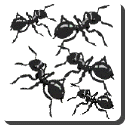 Ants — Ants are eusocial insects of the family Formicidae and, along with the related families of wasps and bees, belong to the order Hymenoptera. They are a diverse group of more than 12,000 species, with a higher diversity in the tropics. They are known for their highly organized colonies and nests, which sometimes consist of millions of individuals. Individuals are divided into sub-fertile, and more commonly sterile, females (“workers”, “soldiers”, and other castes), fertile males (“drones”), and fertile females (“queens”). Colonies can occupy and use a wide area of land to support themselves. Ant colonies are sometimes described as superorganisms because the colony appears to operate as a unified entity.
Ants — Ants are eusocial insects of the family Formicidae and, along with the related families of wasps and bees, belong to the order Hymenoptera. They are a diverse group of more than 12,000 species, with a higher diversity in the tropics. They are known for their highly organized colonies and nests, which sometimes consist of millions of individuals. Individuals are divided into sub-fertile, and more commonly sterile, females (“workers”, “soldiers”, and other castes), fertile males (“drones”), and fertile females (“queens”). Colonies can occupy and use a wide area of land to support themselves. Ant colonies are sometimes described as superorganisms because the colony appears to operate as a unified entity.
Ants have colonized almost every landmass on Earth. The only places lacking indigenous ant species are Antarctica, Greenland, Iceland, parts of Polynesia, the Hawaiian Islands, and other remote or inhospitable islands. When all their individual contributions are added up, they may constitute up to 15 to 25% of the total terrestrial animal biomass.
Termites, sometimes called white ants, are not closely related to ants, although they have similar social structures. Velvet ants, although resembling large ants, are wingless female wasps.
Ants show a wide range of morphological differences between the castes. While in some species, these differences are small, they are large in others. In some ant species there can be several size variants within the worker castes. Workers cannot mate; however, because of the haplodiploid sex-determination system in ants, workers of a number of species are able to lay unfertilized eggs leading to fully functional haploid males. The role of workers may change with their age and in some species, young workers are fed until their gasters are distended, and play a role in food storage. These workers with a storage role are termed repletes.
Ants communicate with each other through chemicals called pheromones, these signal messages are more developed in ant species than in other hymenopterans groups. Like other insects, ants smell with their long and thin antennae that are fairly mobile. The antennae have a distinct elbow joint after an elongated first segment; and since they come in pairs—rather like binocular vision or stereophonic sound equipment—they provide information about direction as well as intensity. Since ants spend their life in contact with the ground, the soil surface makes a good place to leave a pheromone trail that can be followed by other ants. In those species which forage in groups, when a forager finds food they mark a trail on the way back to the colony, and this is followed by other ants that reinforce the trail when they head back to the colony. When the food is exhausted, no new trails are marked by returning ants and the scent slowly dissipates. This behavior helps ants adapt to changes in their environment. When an established path to a food source is blocked by a new obstacle, the foragers leave the path to explore new routes. If successful, the returning ant leaves a new trail marking the shortest route. Successful trails are followed by more ants, and each reinforces the trail with more pheromone (ants will follow the heaviest marked trails). Home is often located by remembered landmarks in the area and by the position of the sun; ants’ compound eyes have specialized cells that detect polarized light, used to determine direction.
 Kids Portal For Parents India Kids Network
Kids Portal For Parents India Kids Network
